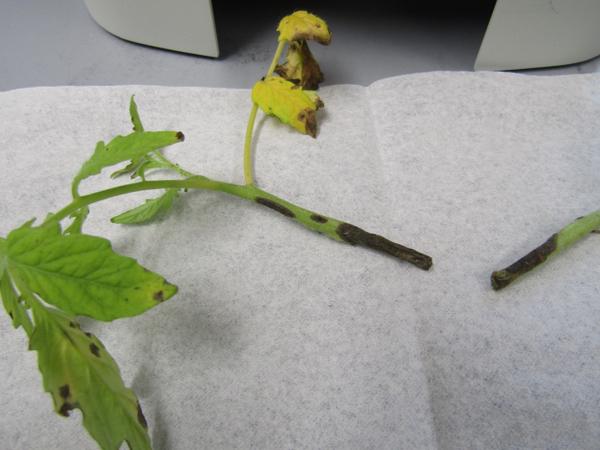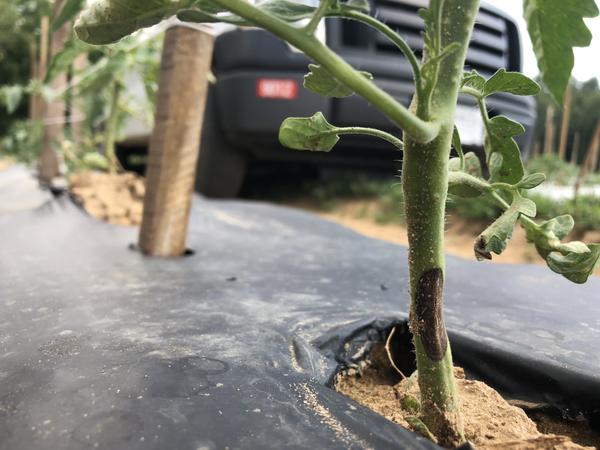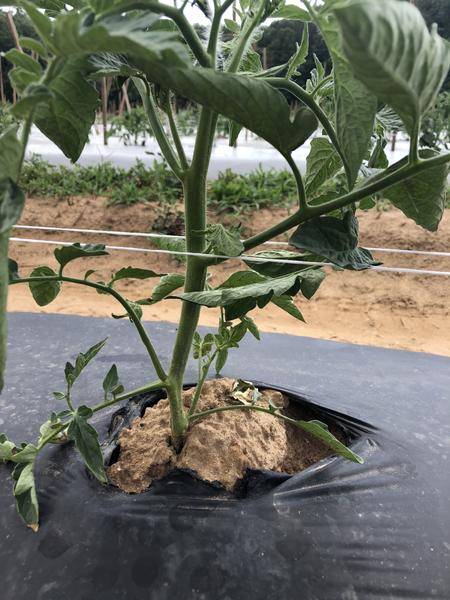General Information
Collar rot and Alternaria stem canker of tomato are both caused by fungal pathogens in the genus Alternaria. Both pathogens can cause large, irregularly shaped stem lesions with pronounced concentric rings. However, the concentric rings may not always be pronounced with collar rot. Collar rot is caused by the same pathogen, A. linariae, that causes early blight of tomato. Early blight is more commonly seen on field grown tomatoes and occurs on the foliage, stem, and fruit. However, if stem-infected tomato seedlings are set in the field, stem lesions will enlarge and eventually girdle the plants. This phase of the disease is referred to as collar rot.
In contrast, Alternaria stem canker is caused by A. alternata f. sp. lycopersici and is primarily a problem of coastal-grown tomatoes in California. Symptoms of Alternaria stem canker can appear on the stems, leaves, and fruit of tomato plants. This disease is not as much of a problem as many (or most) commercial tomato varieties have resistance to Alternaria stem canker. However, if susceptible varieties are used, the disease can occur in North Carolina.
When tomato transplants develop either collar rot or Alternaria stem canker in greenhouses or seedbeds, stem lesions can result in severe losses. Humid climates and semiarid climates with frequent dews that provide high moisture (≥ 90% relative humidity) are conducive for both collar rot and Alternaria stem canker.
|
Collar Rot |
Alternaria Stem Canker |
|
Causes large, irregularly shaped stem lesions with or without pronounced concentric rings. |
Causes large, irregularly shaped stem lesions with pronounced concentric rings |
|
Caused by the fungal pathogen Alternaria linariae, which also causes early blight of tomato. |
Caused by the fungal pathogen Alternaria alternata f. sp. lycopersici |
|
Spores are beaked, multicelled, dark brown to black, 12-20 x 83-117 µm in size, and can be borne singly or, less frequently, in chains of two. |
Spores formed in chains of 3-5, light olive brown to dark brown, “hand grenade” shaped with a shorter, beaked apical cell on the terminal end. They are multicelled and 7-18 x 18-50 µm in size. |
|
Although there are no collar rot resistant varieties, it is recommended to use varieties that are more tolerant to early blight. |
Primarily managed by planting resistant varieties. |
|
If greenhouse facilities have a history of collar rot, use preventative fungicides. |
Fungicides do not efficiently control Alternaria stem canker on susceptible tomato varieties. |
|
Can survive in soil between crop seasons and rotation out of tomato for 2-3 years can reduce disease. |
Can survive indefinitely in the soil as a saprophyte and crop rotation is not effective. |
Pathogen
Collar rot is caused by the pathogen Alternaria linariae (=A. tomatophila; formerly known as A. solani). In addition to tomatoes, cucumbers and chili peppers are also hosts for this fungus.
Alternaria stem canker is caused by the pathogen Alternaria alternata f. sp. lycopersici (=Clathrospora diplospora). Several other Solanaceous plants also are susceptible to this fungus.
Symptoms and Signs
In seedlings, collar rot stem lesions are small, dark, and slightly sunken. As they enlarge, they will form circular or elongated lesions with or without pronounced concentric rings with light centers. Once the infected seedlings are planted in the field, the lesions will continue to enlarge around the stem and girdle the plants. Affected plants will often die, but if they do survive, their growth and yield will likely be reduced.
Alternaria stem canker is characterized by the formation of large, irregularly shaped, dark-brown to almost black cankers with light and dark concentric rings on stems near the soil line. Cankers will enlarge as the plant grows causing girdled stems, stem death, and plant collapse. Vascular and pith tissue directly above and below the cankers may have brown streaks and become cracked and dry. A. alternata f. sp. lycopersici produces toxins that move through the plant resulting in leaf and fruit lesions.
Under a light microscope, spores of A. linariae and A. alternata f. sp. lycopersici can be readily observed in diseased tissue. Conidia (asexual spores) of A. linariae are beaked, muriform (multicelled), dark brown to black, 12-20 x 83-117 µm in size, and can be borne singly or, less frequently, in chains of two. In contrast, conidia of A. alternata f. sp. lycopersici are formed in chains, light olive brown to dark brown, “hand grenade” shaped, have three to five cross septa with longitudinal septa in the second and third cells, and a shorter, beaked apical cell on the terminal end. Conidia are 7-18 x 18-50 µm in size.
Disease Cycle and Epidemiology
A. linariae (collar rot) can survive between crop seasons on infected debris in the soil and on seed. In locations with mild-weather conditions, the pathogen can survive from season to season on volunteer tomato plants. Spores can be spread during periods of heavy rain, continued dew, and overhead irrigation. Disease development is favored by warm temperatures (75 to 84 °F), high humidity, and moderate to heavy rainfall. Collar rot infections typically start in the greenhouse. If infected seedlings are planted in the field, lesions will enlarge and girdle the plants resulting in yield loss.
In contrast, A. alternata f. sp. lycopersici can survive indefinitely in the soil as a saprophyte (a fungus that can live on dead or decaying organic matter). Infection occurs when plants come in contact with infested plant residue or soil, or when conidia are blown or splashed onto susceptible tomato plants. Warm temperatures above 77 °F, high humidity, and moderate to heavy rainfall favor the development of Alternaria stem canker.
General Disease Management
Losses from collar rot and Alternaria stem canker can be reduced by adopting the following management strategies:
Both diseases:
- Use pathogen-free certified seeds and disease-free transplants to prevent the introduction of the pathogen into greenhouses and field production areas.
- Avoid overhead irrigation, especially if susceptible varieties are used.
- Remove volunteer weeds from greenhouse and field production areas that can serve as a source of inoculum.
- Avoid handling wet plants.
- Trays, benches, tools, and greenhouse structures should be washed and sanitized between seedling crops.
- In the greenhouse, scout for collar rot and Alternaria stem canker routinely and remove infected seedlings.
Collar rot:
- Although there are no collar rot resistant varieties, it is recommended to use varieties such as ‘Mountain Merit’ that are more tolerant to early blight.
- Maintain plant vigor with adequate fertilization to reduce susceptibility to collar rot.
- Rotation out of tomato for 2-3 years can reduce collar rot.
- If greenhouse facilities have a history of collar rot, use preventative fungicides.
- If collar rot is caught early, then you can build up soil around the stem lesions and the plants may recover.
Alternaria stem canker:
-
Planting resistant varieties such as ‘Florida 47R,’ ‘Phoenix,’ and ‘Mariana’ can eliminate serious outbreaks of Alternaria stem canker. Note: These varieties do not confer resistance to the collar rot (early blight) pathogen.
-
Rotation is not an effective control strategy for Alternaria stem canker because A. alternata f. sp. lycopersici can survive indefinitely in the soil as a saprophyte.
Disease Control for Conventional Growers
There are several products that are effective for managing early blight, which reduce the occurrence of collar rot (Table 2). However, fungicides do not efficiently control Alternaria stem canker on susceptible tomato varieties.
For the latest fungicide recommendations for early blight of tomato, see the Southeastern US Vegetable Crop Handbook.
|
Active Ingredient |
Example Product |
PHI (days)1 |
FRAC Group2 |
Greenhouse and/or Field3 |
|
AzoxystrobinR |
Quadris |
0 |
11 |
Field Only |
|
AzoxystrobinR + difenoconazole |
Quadris Top |
0 |
11 + 3 |
Field Only |
|
Boscalid |
Endura |
0 |
7 |
Field Only |
|
Cyprodinil + fludioxonil |
Switch 62.5 WG |
0 |
9 + 12 |
Both |
|
Difenoconazole + cyprodinil |
Inspire Super |
0 |
3 + 9 |
Field Only |
|
Fluopyram + pyrimethanil |
Luna Tranquility |
1 |
7 + 9 |
Both |
|
Penthiopyrad |
Fontelis |
0 |
7 |
Both |
|
PyraclostrobinR |
Cabrio EG |
0 |
11 |
Field Only |
|
PyraclostrobinR + fluxapyroxad |
Priaxor |
7 |
11 + 7 |
Field Only |
|
Pyrimethanil |
Scala SC |
1 |
9 |
Both |
|
TrifloxystrobinR + fluopyram |
Luna Sensation |
3 |
11 + 7 |
Both |
|
1 PHI = preharvest interval. |
||||
Disease Control for Organic Growers and Home Owners
For organic control, the cultural control measures described above are the best means of control.
Several copper-based fungicides can reduce the severity of disease. Consult the Organic Materials Review Institute (OMRI) pesticide list for approved products.
Resources
- The NC State University Plant Disease and Insect Clinic provides diagnostics and control recommendations
- The NC State Extension Plant Pathology Portal provides information on crop disease management
- The Southeastern US Vegetable Crop Handbook provides information on vegetable disease management
- The USDA Fungus-Host Distributions Database provides information about reported hosts for fungal and oomycete pathogens
Acknowledgments
This disease factsheet was prepared by the Meadows Plant Pathology Lab.
Funding for updating this fact sheet comes from the United States Department of Agriculture (USDA)-National Institute of Food and Agriculture (NIFA) (2017-70006-27141).
Publication date: April 2, 2019
Reviewed/Revised: Jan. 12, 2024
N.C. Cooperative Extension prohibits discrimination and harassment regardless of age, color, disability, family and marital status, gender identity, national origin, political beliefs, race, religion, sex (including pregnancy), sexual orientation and veteran status.
Recommendations for the use of agricultural chemicals are included in this publication as a convenience to the reader. The use of brand names and any mention or listing of commercial products or services in this publication does not imply endorsement by NC State University or N.C. A&T State University nor discrimination against similar products or services not mentioned. Individuals who use agricultural chemicals are responsible for ensuring that the intended use complies with current regulations and conforms to the product label. Be sure to obtain current information about usage regulations and examine a current product label before applying any chemical. For assistance, contact your local N.C. Cooperative Extension county center.
N.C. Cooperative Extension prohibits discrimination and harassment regardless of age, color, disability, family and marital status, gender identity, national origin, political beliefs, race, religion, sex (including pregnancy), sexual orientation and veteran status.







